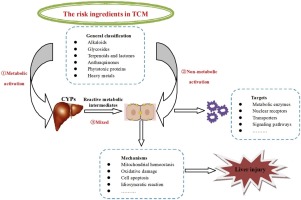当前位置:
X-MOL 学术
›
Toxicol. Lett.
›
论文详情
Our official English website, www.x-mol.net, welcomes your feedback! (Note: you will need to create a separate account there.)
Classification, hepatotoxic mechanisms, and targets of the risk ingredients in traditional Chinese medicine-induced liver injury
Toxicology Letters ( IF 3.5 ) Pub Date : 2020-05-01 , DOI: 10.1016/j.toxlet.2020.01.026 Xiaoqi Pan 1 , Jie Zhou 2 , Yan Chen 3 , Xiaofang Xie 2 , Chaolong Rao 3 , Jie Liang 3 , Ying Zhang 3 , Cheng Peng 2
Toxicology Letters ( IF 3.5 ) Pub Date : 2020-05-01 , DOI: 10.1016/j.toxlet.2020.01.026 Xiaoqi Pan 1 , Jie Zhou 2 , Yan Chen 3 , Xiaofang Xie 2 , Chaolong Rao 3 , Jie Liang 3 , Ying Zhang 3 , Cheng Peng 2
Affiliation

|
Traditional Chinese medicine (TCM) has become a crucial cause of drug-induced liver injury (DILI). Differ from chemical medicines, TCM feature more complex and mostly indefinite components. This review aimed to clarify the classification, underlying mechanisms and targets of the risk components in TCM-induced liver injury to further guide the secure application of TCM. Relevant studies or articles published on the PubMed database from January 2008 to December 2019 were searched. Based on the different chemical structures of the risk ingredients in TCM, they are divided into alkaloids, glycosides, toxic proteins, terpenoids and lactones, anthraquinones, and heavy metals. According to whether drug metabolism is activated or hepatocytes are directly attacked during TCM-induced liver injury, the high-risk substances can be classified into metabolic activation, non-metabolic activation, and mixed types. Mechanisms of the hepatotoxic ingredients in TCM-induced hepatotoxicity, including cytochrome P450 (CYP450) induction, mitochondrial dysfunction, oxidative damage, apoptosis, and idiosyncratic reaction, were also summarized. The targets involved in the risk ingredient-induced hepatocellular injury mainly include metabolic enzymes, nuclear receptors, transporter, and signaling pathways. Our periodic review and summary on the risk signals of TCM-induced liver injury must be beneficial to the integrated analysis on the multi-component, multi-target, and multi-effect characteristic of TCM-induced hepatotoxicity.
中文翻译:

中医药性肝损伤危险成分的分类、肝毒性机制及作用靶点
中医药(TCM)已成为药物性肝损伤(DILI)的重要原因。与化学药物不同,中医的成分更复杂,而且大多是不确定的。本综述旨在阐明中医药肝损伤危险因素的分类、机制和作用靶点,以进一步指导中医药的安全应用。检索了 2008 年 1 月至 2019 年 12 月在 PubMed 数据库上发表的相关研究或文章。根据中药中危险成分的化学结构不同,分为生物碱类、甙类、毒蛋白类、萜类及内酯类、蒽醌类、重金属类。根据中医肝损伤过程中是否激活药物代谢或直接攻击肝细胞,高危物质可分为代谢活化型、非代谢活化型和混合型。还总结了中药肝毒性中肝毒性成分的作用机制,包括细胞色素 P450 (CYP450) 诱导、线粒体功能障碍、氧化损伤、细胞凋亡和特异质反应。危险成分致肝细胞损伤的靶点主要包括代谢酶、核受体、转运蛋白和信号通路。对中医药肝损伤风险信号的定期回顾和总结,必有利于对中医药肝毒性的多成分、多靶点、多效应特征的综合分析。还总结了细胞色素 P450 (CYP450) 诱导、线粒体功能障碍、氧化损伤、细胞凋亡和特异质反应。危险成分致肝细胞损伤的靶点主要包括代谢酶、核受体、转运蛋白和信号通路。对中医药肝损伤风险信号的定期回顾和总结,必有利于对中医药肝毒性的多成分、多靶点、多效应特征的综合分析。还总结了细胞色素 P450 (CYP450) 诱导、线粒体功能障碍、氧化损伤、细胞凋亡和特异质反应。危险成分致肝细胞损伤的靶点主要包括代谢酶、核受体、转运蛋白和信号通路。对中医药肝损伤风险信号的定期回顾和总结,必有利于对中医药肝毒性的多成分、多靶点、多效应特征的综合分析。
更新日期:2020-05-01
中文翻译:

中医药性肝损伤危险成分的分类、肝毒性机制及作用靶点
中医药(TCM)已成为药物性肝损伤(DILI)的重要原因。与化学药物不同,中医的成分更复杂,而且大多是不确定的。本综述旨在阐明中医药肝损伤危险因素的分类、机制和作用靶点,以进一步指导中医药的安全应用。检索了 2008 年 1 月至 2019 年 12 月在 PubMed 数据库上发表的相关研究或文章。根据中药中危险成分的化学结构不同,分为生物碱类、甙类、毒蛋白类、萜类及内酯类、蒽醌类、重金属类。根据中医肝损伤过程中是否激活药物代谢或直接攻击肝细胞,高危物质可分为代谢活化型、非代谢活化型和混合型。还总结了中药肝毒性中肝毒性成分的作用机制,包括细胞色素 P450 (CYP450) 诱导、线粒体功能障碍、氧化损伤、细胞凋亡和特异质反应。危险成分致肝细胞损伤的靶点主要包括代谢酶、核受体、转运蛋白和信号通路。对中医药肝损伤风险信号的定期回顾和总结,必有利于对中医药肝毒性的多成分、多靶点、多效应特征的综合分析。还总结了细胞色素 P450 (CYP450) 诱导、线粒体功能障碍、氧化损伤、细胞凋亡和特异质反应。危险成分致肝细胞损伤的靶点主要包括代谢酶、核受体、转运蛋白和信号通路。对中医药肝损伤风险信号的定期回顾和总结,必有利于对中医药肝毒性的多成分、多靶点、多效应特征的综合分析。还总结了细胞色素 P450 (CYP450) 诱导、线粒体功能障碍、氧化损伤、细胞凋亡和特异质反应。危险成分致肝细胞损伤的靶点主要包括代谢酶、核受体、转运蛋白和信号通路。对中医药肝损伤风险信号的定期回顾和总结,必有利于对中医药肝毒性的多成分、多靶点、多效应特征的综合分析。


























 京公网安备 11010802027423号
京公网安备 11010802027423号